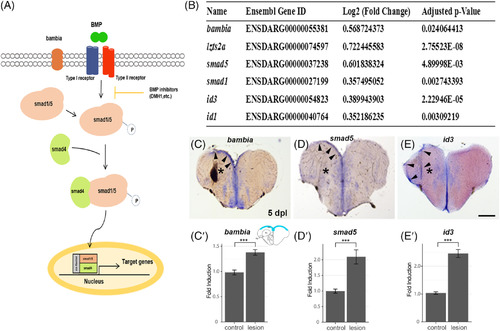Fig. 6
- ID
- ZDB-FIG-210510-30
- Publication
- Zhang et al., 2020 - Bone morphogenetic protein signaling regulates Id1-mediated neural stem cell quiescence in the adult zebrafish brain via a phylogenetically conserved enhancer module
- Other Figures
- All Figure Page
- Back to All Figure Page
|
Genes involved in canonical BMP signaling are induced in response to telencephalic injury. A, Scheme of the BMP signaling pathway. B, RNAseq analysis of injured telencephala hemispheres in comparison to uninjured hemispheres reveals an upregulation in mRNA expression of BMP signal transducers (smad5), regulators (bambia) or downstream target genes (id3, id1). C‐E, In situ hybridization on sections of the adult zebrafish telencephalon 5 days postlesion. C, bambia, D, smad5, E, id3. Arrowheads indicate upregulation of gene expression in the left telencephalic hemisphere upon stab injury. C′‐E′, Quantification of C´bambia, D′, smad5, and E′, id3 expression upregulation 5 days postlesion. Only upregulated areas were quantified along the control and injured ventricular zone from the dorsomedial to the dorsolateral region of the telencephalon (scheme in the upper right‐ hand corner of (C′) shows the quantified area in blue). Significance is indicated by asterisks: ***P < .001. P‐values: bambia: 0.00008917 (C′), smad5: 0.003684 (D′), id3: 7.455 x 10−7 (E′). Scale bar = 200 μm (C, D, E) |

